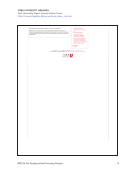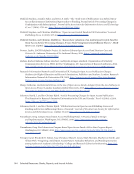7 SPEC Kit 353: Funding Article Processing Charges
subscription market. Practices such as caps on per-article funding are a price control with no equivalent
in journal subscriptions.
However, the problems of APC funds are just as numerous. Perhaps the largest problem is that
there is no easy way to transfer funding from journal subscription budgets, so APC funds become an
additional cost to libraries or their institutions. A survey of Canadian libraries found that fluctuations
in requests can make budgeting for APC funds difficult.17 There are also signs that APCs have continued
the market concentration in scholarly journals, with one survey finding that 10 publishers received 92%
of the APCs.18 For those funds that exclude grant-funded authors, grant support can be difficult to verify,
and there can be problems when articles are accepted after grant funding has ended. Beyond institutional
needs, there are wider concerns that APC costs cannot be met by researchers from developing countries
or without an institutional affiliation, even though some journals have waiver policies.
One limitation of this survey is that it includes only ARL member institutions. Institutional
OA funds for APCs exist around the world, and also include many medium and small North American
institutions.19 A significant limitation of all surveys of central APC funds at institutions is that these
funds likely cover only a minority of APCs paid on those campuses. One institution without an APC
fund acknowledged this by commenting “...we believe that funding for APCs is going on but in a
distributed way outside of library operations.” Evidence from the literature indicates that institutions
only account for about a quarter of the APCs paid.20 Research on APC spending is severely hampered
because institutions lack comprehensive data on the APCs paid by their authors. Future research would
be enabled if APC funds published open data on their expenditures, as institutions in Austria, Germany,
and the United Kingdom already are.21 This action would improve decision-making and embody the data
practices that many ARL libraries are communicating to their researchers. Future research on OA funds
would also be aided by libraries with current or discontinued funds recording information on those
respective wiki pages at the Open Access Directory.
This survey, as well as the existing literature, suggest numerous avenues for further research:
• How can libraries create budget flexibility to support both
subscriptions and OA publishing, including APCs?
• What are author attitudes toward APC funds, and how do the funds
affect the relevance of the library to the institution?
• What is the role of consortia in APC funding? Could APCs be included in negotiations
with publishers? Could consortia support authors at institutions without a fund?
• Which departments on campus provide APC funding to their
authors? What is the fund size and what are their policies?
• What are the outcomes when co-authors from other institutions are not supported?
If the APC-based article is published, what source(s) covered the remaining cost?
• How can library or institutional APC funds be assessed? How is success measured?
Could OA funds be measured as a percentage of collections budgets? Could the number
of articles funded be measured as a percentage of an institution’s total article output?
Conclusion
Most ARL libraries support OA in a variety of ways and are bringing discussions about OA to the
forefront not only through APC funds but also by funding external OA initiatives, hosting OA events, and
holding conversations with faculty and researchers. Libraries are addressing the challenges of changing
publishing models, but since the majority of respondents to this survey have either discontinued support
for APCs, or have decided not to start, it is clear the community is not wholeheartedly convinced that
paying for APCs is the best way to change the traditional business model.
subscription market. Practices such as caps on per-article funding are a price control with no equivalent
in journal subscriptions.
However, the problems of APC funds are just as numerous. Perhaps the largest problem is that
there is no easy way to transfer funding from journal subscription budgets, so APC funds become an
additional cost to libraries or their institutions. A survey of Canadian libraries found that fluctuations
in requests can make budgeting for APC funds difficult.17 There are also signs that APCs have continued
the market concentration in scholarly journals, with one survey finding that 10 publishers received 92%
of the APCs.18 For those funds that exclude grant-funded authors, grant support can be difficult to verify,
and there can be problems when articles are accepted after grant funding has ended. Beyond institutional
needs, there are wider concerns that APC costs cannot be met by researchers from developing countries
or without an institutional affiliation, even though some journals have waiver policies.
One limitation of this survey is that it includes only ARL member institutions. Institutional
OA funds for APCs exist around the world, and also include many medium and small North American
institutions.19 A significant limitation of all surveys of central APC funds at institutions is that these
funds likely cover only a minority of APCs paid on those campuses. One institution without an APC
fund acknowledged this by commenting “...we believe that funding for APCs is going on but in a
distributed way outside of library operations.” Evidence from the literature indicates that institutions
only account for about a quarter of the APCs paid.20 Research on APC spending is severely hampered
because institutions lack comprehensive data on the APCs paid by their authors. Future research would
be enabled if APC funds published open data on their expenditures, as institutions in Austria, Germany,
and the United Kingdom already are.21 This action would improve decision-making and embody the data
practices that many ARL libraries are communicating to their researchers. Future research on OA funds
would also be aided by libraries with current or discontinued funds recording information on those
respective wiki pages at the Open Access Directory.
This survey, as well as the existing literature, suggest numerous avenues for further research:
• How can libraries create budget flexibility to support both
subscriptions and OA publishing, including APCs?
• What are author attitudes toward APC funds, and how do the funds
affect the relevance of the library to the institution?
• What is the role of consortia in APC funding? Could APCs be included in negotiations
with publishers? Could consortia support authors at institutions without a fund?
• Which departments on campus provide APC funding to their
authors? What is the fund size and what are their policies?
• What are the outcomes when co-authors from other institutions are not supported?
If the APC-based article is published, what source(s) covered the remaining cost?
• How can library or institutional APC funds be assessed? How is success measured?
Could OA funds be measured as a percentage of collections budgets? Could the number
of articles funded be measured as a percentage of an institution’s total article output?
Conclusion
Most ARL libraries support OA in a variety of ways and are bringing discussions about OA to the
forefront not only through APC funds but also by funding external OA initiatives, hosting OA events, and
holding conversations with faculty and researchers. Libraries are addressing the challenges of changing
publishing models, but since the majority of respondents to this survey have either discontinued support
for APCs, or have decided not to start, it is clear the community is not wholeheartedly convinced that
paying for APCs is the best way to change the traditional business model.
























































































































































